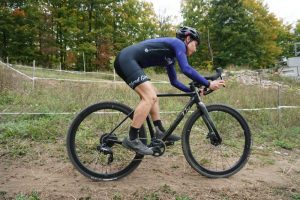About twice a week, someone asks (or tells) me about the efficiency of their indoor training. You can look up forum discussions where people discuss how outdoor training is wasteful because of time ‘lost’ to coasting, descending, getting lost, getting dressed, finding a route, stopping at lights, and fixing flats. They are 100% right, training indoors achieves the goal of filling your hour of training with a bunch of pedaling. Indoors training is ‘time-efficient’ but is it efficient at goal achievement?
*I will focus on the indoor trainer in this article but this could be extended to flat road cycling or any other way we might try to make a workout less variable or ‘perfect’.

Efficient at Accomplishing What Goal?
Efficiency suggests that it doesn’t waste resources (e.g. time) but accomplishes the goal. Training indoors—especially training exclusively indoors—might be efficient at achieving the goal of a higher average power or more TSS but what does that restricted indoor environment not have? Balance, navigation, fueling, clothing, riding with people, technical skills, and tactics. That list of things missing in the indoor environment is similar to the reasons so many people say indoor training is more efficient! Again, indoor training is efficient but what goal is it achieving?
It is important that we look at the cost of efficiency as well. By not fixing flats, stopping (and starting), navigating a route, getting dressed, or coasting (e.g. technical skills/descending/cornering), you can start seeing how a truly efficient ride that accomplishes the goal of finishing a long, hot, hilly gravel or mountain bike race might mean getting outside more often, even if it isn’t time-efficient, burns fewer calories, or rates lower on the ‘suffer score’.
*more on determinants of performance in this study
Use All of Your Tools
With busy Consummate Athletes, we use all available tools. There is no denying that to build your ‘cycling engine’ the indoor trainer is great. The trick is to find a balance that prepares you for the race demands but also balances your time available and your family/work values. It might sound like we think you should only do specific training that looks exactly like race day. But that’s not the case. We typically aim for 2 to 3 days where you can ride in your goal discipline. Those other days can certainly be indoors or on a road bike in the city to be more ‘time-efficient’ and to work more on building your engine.
You can do anything, but you can’t do everything
Two of the Consummate Athlete tactics (covered in our book) are being organized with your equipment and (actually) planning out the seasonal schedule with your family/work. These tactics give you a chance to do the specific training you need to do without cramming your training into a limited time. This often means fewer big goals but really expands the fun you can have in your training and life. Our experience is that this leads to much better races/events/adventures and it makes the training something you enjoy and that you want to do.
We often ask ‘Can You Prepare for the Goal that You Have Set‘ and suggest that you ‘Race if you are Going to Race‘. If your life is full (e.g. hectic!) right now and you need to be uber-efficient and cram training in, it might be worth deferring or reducing your big scary goals to give yourself time to enjoy the process. As they say, you can do anything, but you can’t do everything.
Efficient Example
Let’s pretend you are a busy executive who doesn’t have a lot of time to train, but you’ve signed up for the Leadville 100 MTB race and it’s coming up in under three months.
- Inefficient Training – Expensive, high-cost goal achievement: This example might seem unreasonable but it is more common than you think. This rider trains like a pro, they drive to the trailheads and get in every hour the pro-level training plan suggests but their family and work are not impressed. Those early mornings and late nights affect their health. They risk family issues, career setbacks, and health issues. They get the finisher’s belt buckle but at what cost?
- Time Efficient: This rider spends their time on the trainer and rarely gets out on trails, hills, their race bike, in the heat, or on group rides. On race day, they find themselves losing time on descents, and corners, and missing chances to draft in groups, a few crashes leave them rattled early in the 100-mile event. They might finish the race but the training in the months before was not enjoyable and the results were frustrating.
- Efficient at Goal Achievement: During the week, this rider does two rides on the trainer before work, and one day each week they get outside for about 90 minutes on their race bike on city trails/paths. On weekends, they trade off taking care of the kids with their spouses. They do a short, hard ride on Saturday and a bigger ride on Sunday where they gameplay race day fueling, equipment, and tactics. They also schedule one weekend each month for a big training weekend where they travel to trails that are similar to the race (a few of these are coupled with family trips/vacations). This athlete enjoys the variety in training, balances work/family values, and arrives on race day prepared and confident.
Efficient Training makes for efficient race days – don’t confuse time efficiency with achieving your goals.
Before you go, check out our book, Becoming A Consummate Athlete, right here:
Feature Photo by Aditya Wardhana on Unsplash









